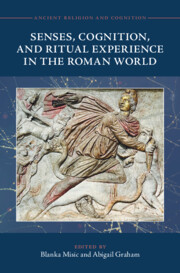Book contents
- Senses, Cognition, and Ritual Experience in the Roman World
- Ancient Religion and Cognition
- Senses, Cognition, and Ritual Experience in the Roman World
- Copyright page
- Contents
- Figures
- Contributors
- Acknowledgements
- Abbreviations
- Introduction Experiencing Rituals
- Chapter 1 Remembering the Rites: Religious Learning Network Model and Transmission of Religious Rituals in the Worship of Nutrices Augustae (Poetovio, Pannonia Superior)
- Chapter 2 The Haptic Production of Religious Knowledge among the Vestal Virgins: A Hands-On Approach to Roman Ritual
- Chapter 3 Haptic Colour: Experiential Viewing in Graeco-Roman Sacred Spaces
- Chapter 4 Nobody Is Gonna Rain on My Parade: Experiencing Salutaris’s Procession As a Ritual Event
- Chapter 5 Objects and Ritual in Egeria’s Fourth-Century Pilgrimage: The Props of My Faith
- Conclusion (Re)Creating Ritual Experiences
- Index
- References
Chapter 3 - Haptic Colour: Experiential Viewing in Graeco-Roman Sacred Spaces
Published online by Cambridge University Press: 04 January 2024
- Senses, Cognition, and Ritual Experience in the Roman World
- Ancient Religion and Cognition
- Senses, Cognition, and Ritual Experience in the Roman World
- Copyright page
- Contents
- Figures
- Contributors
- Acknowledgements
- Abbreviations
- Introduction Experiencing Rituals
- Chapter 1 Remembering the Rites: Religious Learning Network Model and Transmission of Religious Rituals in the Worship of Nutrices Augustae (Poetovio, Pannonia Superior)
- Chapter 2 The Haptic Production of Religious Knowledge among the Vestal Virgins: A Hands-On Approach to Roman Ritual
- Chapter 3 Haptic Colour: Experiential Viewing in Graeco-Roman Sacred Spaces
- Chapter 4 Nobody Is Gonna Rain on My Parade: Experiencing Salutaris’s Procession As a Ritual Event
- Chapter 5 Objects and Ritual in Egeria’s Fourth-Century Pilgrimage: The Props of My Faith
- Conclusion (Re)Creating Ritual Experiences
- Index
- References
Summary
From painted embellishments on altars and temples, marble flooring, dyed sacrificial ribbons and even the colouration of ritual animals, colour was an inescapable aspect of religious experience. Polychromy was not only decorative, it created a visual medium with which those navigating sacred spaces could interact, together with the written word and the language of shape and form. Colour could communicate to the ancient viewer associations of its source; the significance of both where its pigment or dyestuff was harvested and the journey it undertook, both in terms of manufacture and simple geography, in order to arrive before the observer. The very conception of ancient sight, with rays reaching from the eyes in a particularly haptic process of sensory feedback, meant that looking at colours was for the ancient viewer an experience in itself. How would visitors to the sacred spaces of the ancient world have ‘read’ the visual cues surrounding them, and how could the design of colours in ritual spaces influence the reactions and emotions of those witnessing sacred activity? This paper seeks to investigate and unpick some of the chromatic language found in religious spaces to better inform an understanding of ritual activity in Greco-Roman society.
- Type
- Chapter
- Information
- Senses, Cognition, and Ritual Experience in the Roman World , pp. 89 - 117Publisher: Cambridge University PressPrint publication year: 2024

